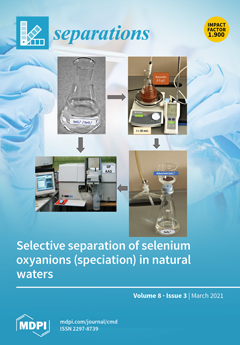Photocatalytic coatings of TiO
2/ZnO/CuPc were developed on stainless steel substrates by subsequent sol gel dip coating for TiO
2, spray pyrolysis for ZnO, and spin coating for copper (ii) phthalocyanine (CuPc) deposition. The latter compound was successfully prepared using a
[...] Read more.
Photocatalytic coatings of TiO
2/ZnO/CuPc were developed on stainless steel substrates by subsequent sol gel dip coating for TiO
2, spray pyrolysis for ZnO, and spin coating for copper (ii) phthalocyanine (CuPc) deposition. The latter compound was successfully prepared using a Schiff-based process. The materials and coatings developed were characterized by X-ray diffraction (XRD), Fourier transform infrared (FTIR) spectroscopy, scanning electron microscopy with attached energy dispersive spectroscopy (SEM-EDS), UV-Vis spectroscopy, room temperature photoluminescence (RTPL) spectroscopy, H1-nuclear magnetic resonance (
1H-NMR) spectroscopy, C13-nuclear magnetic resonance (
13C-NMR) spectroscopy, and matrix-assisted laser desorption/ionization-time of flight (MALDI-TOF) mass spectrometry (MS). The as-deposited TiO
2/ZnO/CuPc on stainless steel retained in pristine state the structural and morphological/spectroscopic characteristics of its respective components. Estimated energy band gap values were 3.22 eV, 3.19 eV, 3.19 eV for TiO
2, ZnO, TiO
2/ZnO respectively and 1.60 eV, 2.44 eV, and 2.92 eV for CuPc. The photocatalytic efficiency of the fabricated TiO
2/ZnO/CuPc coatings was tested toward ibuprofen (IBF). After 4 h irradiation under 365 nm UV, an increased degradation of about 80% was achieved over an initial 5 mg/L ibuprofen (IBF). This was much higher compared to about 42% and 18% IBF degradation by TiO
2/ZnO and TiO
2 thin film, respectively. In all cases, the stability of the best-performing photocatalyst was investigated showing a small decline to 77% of IBF degradation after the 5th cycle run. The effect of pH, reactive oxygen species (ROS) probe, shed light on a possible catalytic mechanism that was suggested.
Full article





